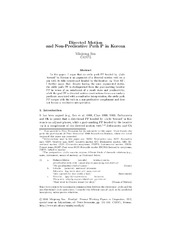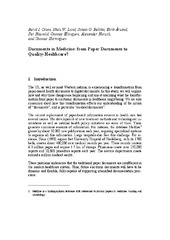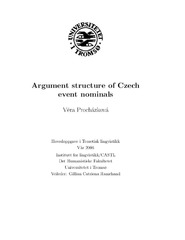Institutt for språk og kultur: Recent submissions
Now showing items 2041-2060 of 2199
-
Directed motion and non-predicative path P in Korean
(Journal article; Tidsskriftartikkel, 2006)In this paper, I argue that an atelic path PP headed by -(u)lo ‘toward’ in Korean is an argument of a directed motion verb on a par with its telic counterpart headed by the locative -ey ‘(be) AT’. I further argue that, despite having the same argumental status, the atelic path PP is distinguished from the goal-marking locative PP in terms of an entailment of a result state and predicativity; while ... -
Aspect and verbal preposition
(Journal article; Tidsskriftartikkel, 2006)In this paper, we explore some previously unanalysed interactions between verbal aktionsart and prepositional complementation in Norwegian, namely the alternations between a DP object and PP complements with på ‘on/at’ and til ‘to/at’. We argue that a simple account based on [±telic] or [±quantized] features cannot be correct. Instead, we generalize the notion of path and homomorphism, and integrate ... -
Body part nouns in expressions of location in French
(Journal article; Tidsskriftartikkel, 2006)In relation to inanimates, nouns that normally denote body parts when constructed in relation to an animate whole (pied ‘foot’, tête ‘head’, etc.) lose their literal meaning in French and acquire instead a spatial interpretation. This paper argues that spatial part Ns in French divide into two coherent groups with distinct properties: fixed spatial part terms, which denote concrete, perceptible ... -
The axial part phrase in Japanese
(Journal article; Tidsskriftartikkel, 2006)In this paper, I investigate the categorial status of spatial terms in locative/directional expressions in Japanese. I will show that a certain class of spatial terms have a distinct categorial status from both regular postpositions and nouns. On one hand, syntactic diagnostics such as doubling, coordination by to, and co-occurrence with demonstratives indicate that these spatial terms belong to a ... -
Categorizing adpositions in Kîîtharaka
(Journal article; Tidsskriftartikkel, 2006)In this paper, I discuss the categorial status of Kîîtharaka adpositions. I demonstrate that there are two main classes of adpositions(to be referred to as Class A and Class B). Class A adpositions are syntactic heads and they belong to the functional lexical category P. Class B adpositions are a phrasal P category with a nominal component. They therefore spell out a complex structure than adpositional ... -
Persian preposition classes
(Journal article; Tidsskriftartikkel, 2006)In this paper I present the prepositional system in Persian. I show that Persian prepositions can be divided into three classes (Class 1, Class 2a and Class 2b) which exhibit distinct syntactic behavior. Then I examine the question of the categorial status of Class 2 prepositions and demonstrate that they are not to be regarded as nouns. Finally I present the extended PP projection of Persian spatial ... -
The degree of verb movement in embedded clauses in three varieties of Norwegian
(Journal article; Tidsskriftartikkel, 2007)The position of the verb(s) in embedded non-V2 contexts varies in Norwegian dialects. In Eastern Norwegian (EastN), all verbs have to follow all adverbs in non-V2 contexts. In Tromsø Northern Norwegian (TrNN) main verbs and non-finite auxiliaries have to follow all adverbs, but finite auxiliaries may precede adverbs they take scope over. In Regional Northern Norwegian (ReNN) all finite verbs ... -
Scandinavian dialect syntax (before and after) 2005
(Journal article; Tidsskriftartikkel, 2007)This paper gives an outline of the goals of the pan-Nordic project umbrella Scandinavian Dialect Syntax and of how the research collaboration is organized and financed, and of how the collaboration has advanced during the last 4-5 years. Special attention is devoted to the NORMS Nordic Center of Excellence project which in effect constitutes a highly focused branch of the larger network. There ... -
Introduction
(Journal article; Tidsskriftartikkel, 2007) -
Documents in medicine. From paper documents to quality-healthcare?
(Chapter; Bokkapittel, 2007) -
Evolving and devolving institutions. A perspective on Norwegian public policy towards the IT industry 1945-2000
(Chapter; Bokkapittel, 2007) -
Text und Paratext und deren Remedierung im Film. Jens Sparschuhs Heimatroman "Der Zimmerspringbrunnen" (1995)
(Chapter; Bokkapittel, 2007) -
Analog sound in the age of digital tools. The story of the failure of digital technology
(Chapter; Bokkapittel, 2007) -
Complementarity – a concept possible to be achieved in document analysis?
(Conference object; Konferansebidrag, 2006-10) -
Building a discipline, creating a profession. An essay on the childhood of “Dokvit”.
(Chapter; Bokkapittel, 2007) -
Argument structure of Czech event nominals.
(Master thesis; Mastergradsoppgave, 2006-06-19)The aim of this work is to contribute to the deeper insight into the internal structure of nominal phrase and the typology of its derivation. After sketching the general theoretical framework in the first chapter and after giving an overview of various types of nominals and distinct approaches to their analysis in chapter 2, I focus on one particular group of deverbal nominals in Czech, namely ... -
Thinking of falling in love with Nenets stories. Questions of readerly reciprocity in Ledkov's "Sineva v arkane"
(Journal article; Tidsskriftartikkel, 2004) -
Ecological politics and comic redemption in Louise Erdrich's "The Antelope Wife"
(Journal article; Tidsskriftartikkel, 2004) -
An essay about indigenous methodology
(Journal article; Tidsskriftartikkel, 2004) -
"Elveland" - irony and laughter as power media in Sea Sami folk-song tradition
(Journal article; Tidsskriftartikkel, 2004)


 English
English norsk
norsk


















